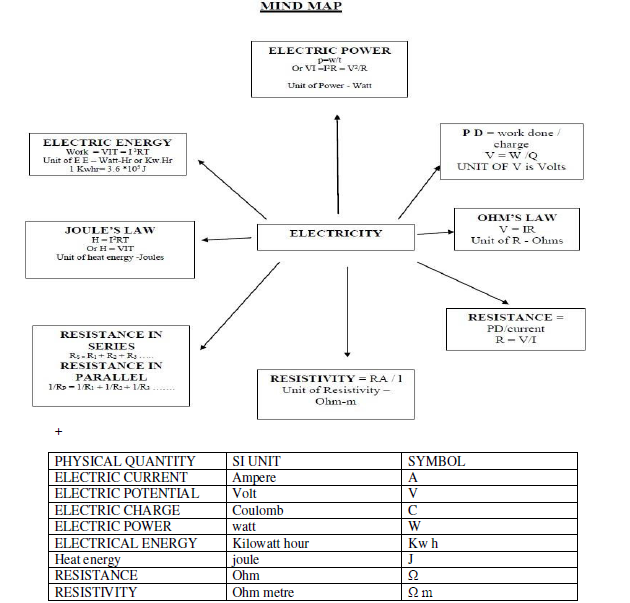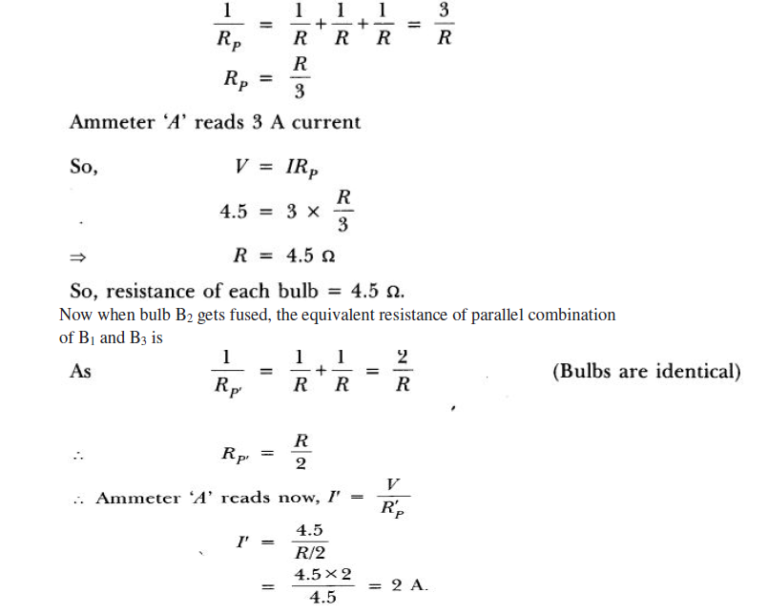Read and download free pdf of CBSE Class 10 Science Electricity Assignment Set D. Get printable school Assignments for Class 10 Science. Class 10 students should practise questions and answers given here for Chapter 11 Electricity Science in Class 10 which will help them to strengthen their understanding of all important topics. Students should also download free pdf of Printable Worksheets for Class 10 Science prepared as per the latest books and syllabus issued by NCERT, CBSE, KVS and do problems daily to score better marks in tests and examinations
Assignment for Class 10 Science Chapter 11 Electricity
Class 10 Science students should refer to the following printable assignment in Pdf for Chapter 11 Electricity in Class 10. This test paper with questions and answers for Class 10 Science will be very useful for exams and help you to score good marks
Chapter 11 Electricity Class 10 Science Assignment

Voltmeter: An apparatus to measure the potential difference or electric potential difference between two points in an electric circuit.
Galvanometer: It is a device to detect current in an electric circuit.
Ammeter: An apparatus to measure electric current in a circuit.
Multiple Choice Questions
Question: A piece of wire of resistance R is cut into five equal parts. These parts are then connected in parallel. If the equivalent resistance of this combination is R’, then the ratio R/R’ is:
(a) 125
(b) 15
(c) 5
(d) 25
Answer: D
Question: Which of the following terms does not represent electrical power in a circuit?
(a) I2R
(b) IR2
(c) VI
(d) V2/ R
Answer: B
Question: An electric bulb is rated 220 V and 100 W. When it is operated on 110 V, the power consumed will be:
(a) 100 W
(b) 75 W
(c) 50 W
(d) 25 W
Answer: D
Short Answer Type Questions
Question.Two resistors of 10 Ω and 15 Ω are connected in series to a battery of 6 V. How can the values of current passing through them be compared?
Answer: In series, same current flows through each resistor. So, ratio of current is 1: 1.
Question. A wire of resistance 20 Ω is bent to form a closed square. What is the resistance across a diagonal of the square?
Answer:
Question. Name a device that helps to maintain a potential difference across a conductor.
Answer: Cell or battery
Question. Write S.I. unit of resistivity.
Answer: Ohm-metre (Ωm).
Question. A 9Ω resistance is cut into three equal parts and connected in parallel. Find the equivalent resistance of the combination.
Answer:
Question. Out of the two wires X and Y shown below, which one has greater resistance? Justify your answer.
Answer: Wire ‘Y’ has greater resistance as it has more length than wire ‘X’. It is because resistance of wire is directly proportional to the length of wire.
Question. V-I graph for two wires A and B are shown in the figure. If both wires are of same length and same thickness, which of the two is made of a material of high resistivity? Give justification for your Answer:
Greater than slope of V-I graph, greater will be the resistance of given metallic wire. In the given graph, wire A has greater slope then B. Hence, wire A has greater resistance. For the wires of same length and same thickness, resistance depends on the nature of material of the wire, i.e.
Question.Define 1 volt. Express it in terms of SI unit of work and charge calculate the amount of energy consumed in carrying a charge of 1 coulomb through a battery of 3 V.
Answer: When 1 joule of work is done in carrying 1 coulomb of charge, from infinity to a point in the electric field, then potential at that point is called 1 volt. Potential difference between two points is
Question. How much current will an electric bulb draw from 220 V source if the resistance of the bulb is 1200Ω? If in place of bulb, a heater of resistance 100 Ω is connected to the sources, calculate the current drawn by it.
Answer:
Question.The figure below shows three cylindrical copper conductors along with their face areas and lengths. Discuss in which geometrical shape the resistance will be highest.
Answer:
Question. Find the current drawn from the battery by the network of four resistors Shown in the figure.
Answer:
Question. B1 B2 and B3 are three identical bulbs connected as shown in figure. When all the three bulbs glow, a current of 3A is recorded by the ammeter A.
Answer:
(i) What happens to the glow of the other two bulbs when the bulb B1 gets fused?
(ii) What happens to the reading of A1, A2, A3 and A when the bulb gets fused?
(iii) How much power is dissipated in the circuit when all the three bulbs glow together?
(i) Since B1, B2 and B3 are in parallel, the potential difference across each of them will remain same. So when the bulb B1 gets fused,B1 ,B2 and B3 have the same potential and continues with the same energy dissipated per second, i.e. they will glow continuously as they were glowing before.
(ii) Resistance of the parallel combination when all the three bulbs are glowing

Since resistance of each arm is same and p.d. is also same, current divides them equally. So 1A current will pass through each bulb Bl and By
Therefore, ammeter A1 and A3 reads l A current while A2 will read zero and ammeter A read 2 A current.
(iii) In parallel, total power consumed
Peq=P1 +P2 +P3
So, when all the three bulbs glow together
Long Answer Type Questions
Question. Two wires A and B are of equal length and have equal resistance. If the resistivity of A is more than that of B, which wire is thicker and why? For the electric circuit given below calculate:
(i) Current in each resistor,
(ii) Total current drawn from the battery, and
(iii) Equivalent resistance of the Circuit
Answer:
So, for different materials having same resistance per unit length, greater resistivity material wire has more cross-sectional area.
Hence, wire A is thicker than that of B.
(i) Current through each resistor
Question. (a)Two resistors R1 and R2 may form (i) a series combination or (ii) a parallel combination, and the combination may be connected to a battery of 6 volts. In which combination, will the potential difference across R1 and across R2 be the same and in which combination, will the current through R1 and through R2 be the same?
(b) For the circuit shown in this diagram, calculate
(i) the resultant resistance.
(ii) the total current.
(iii) the voltage across 7 Ω resistor.
Answer: (a) Potential difference across R1 and R2 is same in parallel combination of R1 and R2 and the current through R1 and R2 will be same when they are connected in series.
Question. A. Two identical wires one of nichrome and other of copper are connected in series and a current (I) is passed through them. State the change observed in the temperatures of the two wires. Justify your answer. State the law which explains the above observation.
B. An electric bulb is rated at 60 W, 240 V. Calculate its resistance. If the voltage drops to 192 V, calculate the power consumed and the current drawn by the bulb. (Assume that the resistance of the bulb remains unchanged.)
Answer: A. The resistivity of nichrome is more than that of copper so its resistance is also high. Therefore, large amount of heat is produced in the nichrome wire for the same current as compared to that of copper wire. Accordingly, more change in temperature is observed in the nichrome wire. This is explained by Joule’s law of heating. Joule’s law of heating: It states that the amount of heat produced in a conductor is

Regardless of whether you wish to have an overview of a chapter, revision notes are here to do it for you. These notes will surely save your time during stressful exam times
| CBSE Class 10 Physics Revision Assignment Set A |
| CBSE Class 10 Physics Revision Assignment Set B |
| CBSE Class 10 Science Assignment |
| CBSE Class 10 Science Assignments Collection |
| CBSE Class 10 Science Energy Crossword Puzzle Assignment |
CBSE Class 10 Science Chapter 11 Electricity Assignment
We hope you liked the above assignment for Chapter 11 Electricity which has been designed as per the latest syllabus for Class 10 Science released by CBSE. Students of Class 10 should download and practice the above Assignments for Class 10 Science regularly. We have provided all types of questions like MCQs, short answer questions, objective questions and long answer questions in the Class 10 Science practice sheet in Pdf. All questions have been designed for Science by looking into the pattern of problems asked in previous year examinations. You can download all Revision notes for Class 10 Science also absolutely free of cost. Lot of MCQ questions for Class 10 Science have also been given in the worksheets and assignments for regular use. All study material for Class 10 Science students have been given on studiestoday. We have also provided lot of Worksheets for Class 10 Science which you can use to further make your self stronger in Science.
What are benefits of doing Assignment for CBSE Class 10 Science Chapter 11 Electricity?
a. Score higher marks: Regular practice of Science Class 10 Assignments for chapter Chapter 11 Electricity will help to improve understanding and help in solving exam questions correctly.
b. As per CBSE pattern: All questions given above follow the latest Class 10 Science Sample Papers so that students can prepare as per latest exam pattern.
c. Understand different question types: These assignments include MCQ Questions for Class 10 Science with answers relating to Chapter 11 Electricity, short answers, long answers, and also case studies.
d. Improve time management: Daily solving questions from Chapter 11 Electricity within a set time will improve your speed and accuracy.
e. Boost confidence: Practicing multiple assignments and Class 10 Science mock tests for Chapter 11 Electricity reduces exam stress.
How to Solve CBSE Class 10 Science Chapter 11 Electricity Assignment effectively?
a. Start with Class 10 NCERT and syllabus topics: Always read the chapter carefully before attempting Assignment questions for Class 10 Science Chapter 11 Electricity.
b. Solve without checking answers: You should first attempt the assignment questions on Chapter 11 Electricity yourself and then compare with provided solutions.
c. Use Class 10 worksheets and revision notes: Refer to NCERT Class 10 Science worksheets, sample papers, and mock tests for extra practice.
d. Revise tricky topics: Focus on difficult concepts by solving Class 10 Science MCQ Test.
e. Maintain notebook: Note down mistakes in Chapter 11 Electricity assignment and read them in Revision notes for Class 10 Science
How to practice CBSE Class 10 Science Chapter 11 Electricity Assignment for best results?
a. Solve assignments daily: Regular practice of Chapter 11 Electricity questions will strengthen problem solving skills.
b.Use Class 10 study materials: Combine NCERT book for Class 10 Science, mock tests, sample papers, and worksheets to get a complete preparation experience.
c. Set a timer: Practicing Class 10 Science Chapter 11 Electricity assignment under timed conditions improves speed and accuracy.
You can download free Pdf assignments for CBSE Class 10 Science Chapter 11 Electricity from StudiesToday.com
All topics given in Chapter 11 Electricity Science Class 10 Book for the current academic year have been covered in the given assignment
No, all Printable Assignments for Chapter 11 Electricity Class 10 Science have been given for free and can be downloaded in Pdf format
Latest syllabus issued for current academic year by CBSE has been used to design assignments for Chapter 11 Electricity Class 10
Yes, we have provided detailed answers for all questions given in assignments for Chapter 11 Electricity Class 10 Science

